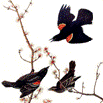Center, Internet, Wildlife Damage Management

Bird Control Seminars Proceedings
Document Type
Article
Date of this Version
9-13-1966
Abstract
We recognized this bird damage problem from an agricultural standpoint around 1950. It seemingly was growing and when we looked into it; it later appeared that this was the case. The problem was quickly resolved to be primarily red-winged blackbirds in corn. We also have problems of damage to fruit crops such as apples, or peaches by starling and other birds, in grapes probably by warblers and most certainly star¬lings in certain seasons. But, this isn't as consistent and persistent at the corn damage by red-winged blackbirds. We began about 8 years ago to make a survey and we got the blessing of everybody concerned to run an ecological project. In this ecological project we were going to determine the life history and the eco¬logy, the interrelationships, the behavior of the blackbirds, and we did this and came up with many of the same results that you've heard about today. That is, the previous speakers have practically summed up our findings. They're the same; they're uniform. In some cases we used their findings to come to some of our conclusions. We also formed an interregional agricultural group to determine what could be done. Because the north central agricultural research experiment station directors were not in accord with operating this program in the north-central region, Ohio joined the northeast region and the chairman, Dr. Philip Granett of Rutgers University, of the northeast region is present at this meeting, and I'll probably have him tell you about this a little bit later. I'm a member of the technical committee of the northeast region experiment station groups in which the experiment station people co¬operate with the fish and wildlife people, in this common problem of preventing crop depredations by birds. We can sum up rather quickly the things that we have done under two headings: one under Evaluation and the other under Ecology. First we've evaluated things. We've evaluated exploders in preventing damage. We've evaluated varieties of corn. We've evaluated insects--insect sprays to keep birds out. We've evaluated diversion crops. Evaluated types of soil. Evaluated different habitats. We've evaluated exploders and alarm cries, shocking devices and chemicals.

